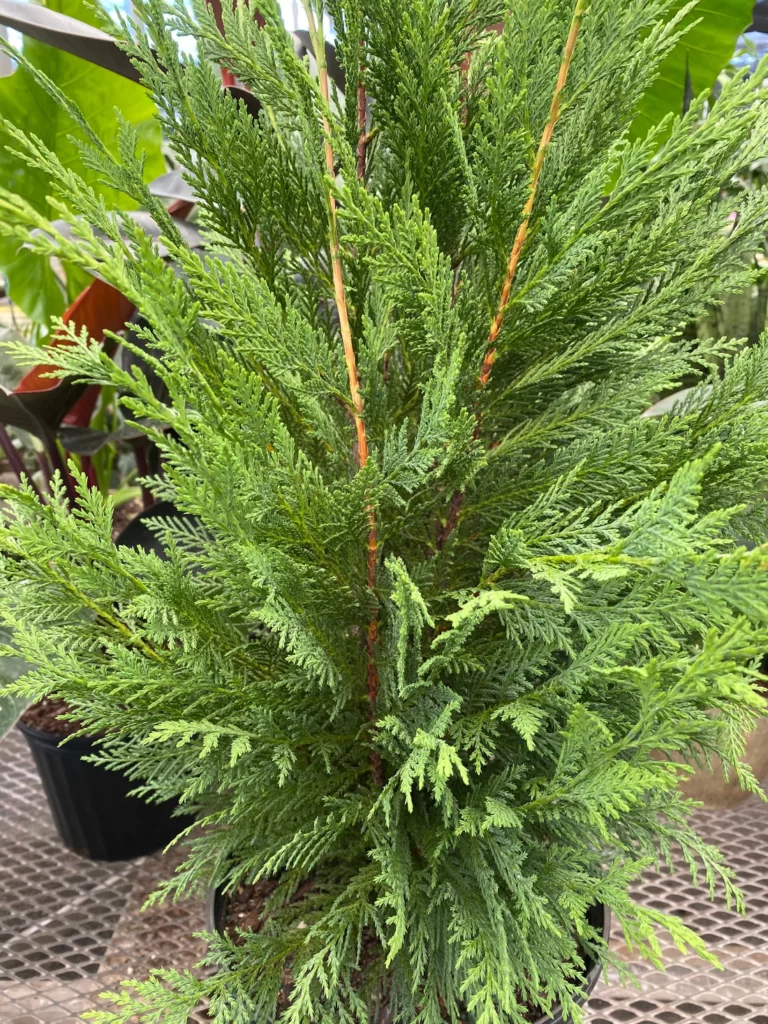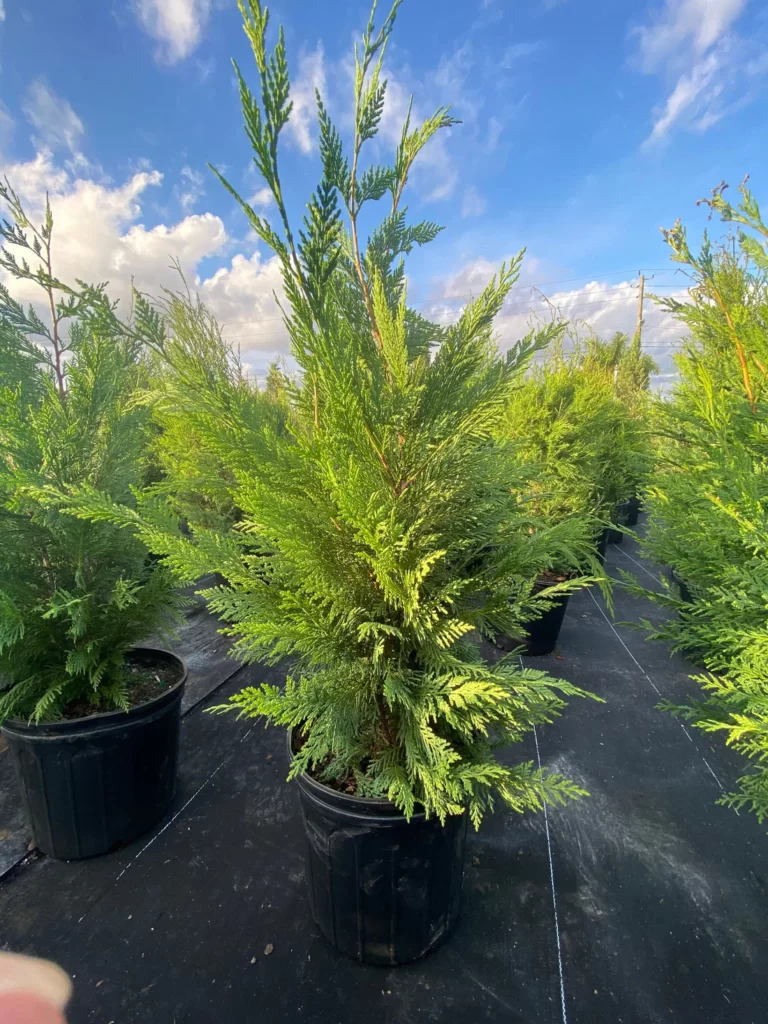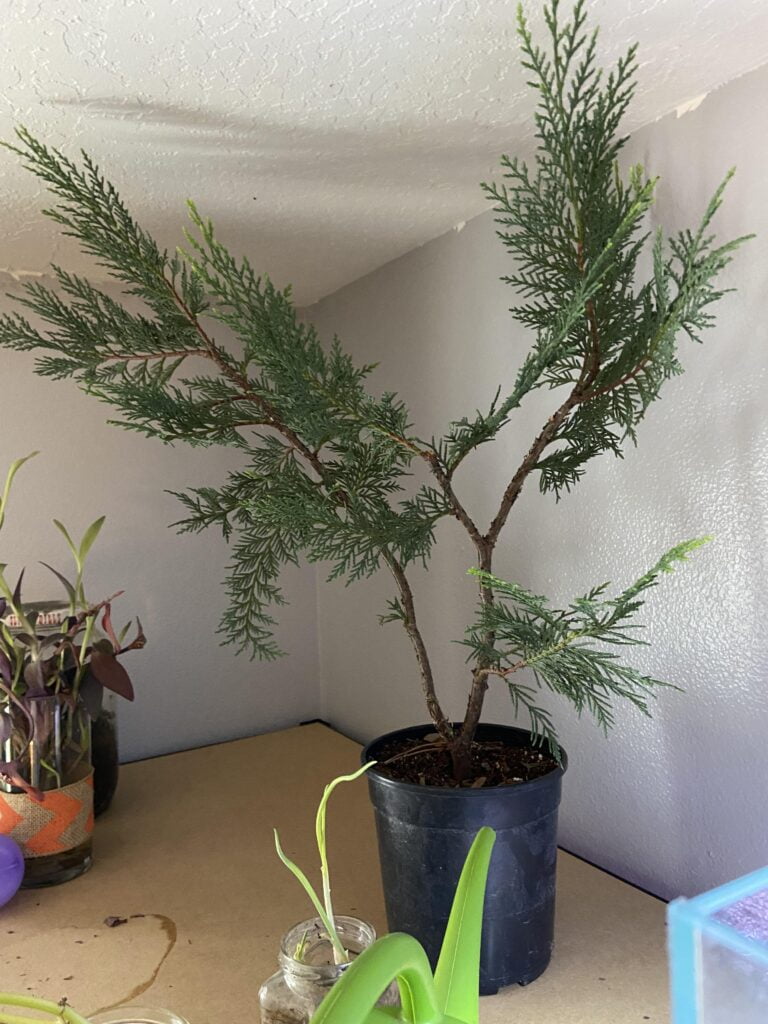Leyland cypress is a hybrid cross between the Monterey cypress and Nootka false cypress, particularly favored by bonsai lovers because of its fast-growing characteristic. Another big reason this tree is so popular is its vibrant green color.
Anybody can do the method of caring for and growing a Leyland cypress. So, here’s a step-by-step guide for Leyland cypress bonsai in detail.
Leyland Cypress Bonsai Quick Facts
| Fact | Description |
| Scientific Name | Cuprocyparis leylandii |
| Family | Cupressaceae |
| Native to | Cultivated hybrid, parents Monterey cypress and Nootka false cypress are from North American natives. |
| Plant Type | Coniferous evergreen tree |
| Lifespan | 10-25 years |
| Height | 60-70 feet tall |
| Leaves | Scale-like mid-green and blue-green leaves |
| Flower | non-flowering |
| Blooming season | non-flowering |
| Fruit | Small, round cones. They are green and with maturing they turn chocolate brown. |
| Cultivation | Bonsai plant |
| Uses | As an ornamental piece, hedges, and boundaries. |
Leyland Cypress Bonsai Care Guide
Caring for a leyland cypress bonsai might seem intimidating at first, but once you get a hang of it, you will enjoy this first-growing stunning beauty. Here’s a full-proof care guide that you can follow with ease.
Leyland Cypress Bonsai Watering
After plantation in spring or summer, Leyland cypress requires regular watering in order to establish its root. The roots take a couple of months to get established and during that time they require plenty of water. But once suppressing this phase the frequency should be lower.
During winter only water it twice or thrice a week, depending on how much time the soil takes to dry. The tree can tolerate small periods of drought and waterlogged, but it’s better not to utilize any irrigation system as they have the potential to overwater, and recovering from drought stress is easier than root rot. The scale-like foliage is soft and prone to get heavy with water, so focus on the base instead of sprinkling water over the tree.
Learn more about Watering a bonsai tree.
Leyland Cypress Bonsai Temperature Tolerance
Leyland cypress usually prefers USDA hardiness zones 6 -10, where the temperature doesn’t drop below minus 8 degrees Fahrenheit most of the year. But zone 5 households can grow them as well by providing mulch and shelter to protect them from harsh winter winds.
In their natural habitat once they got mature they don’t require shelter because they become cold-resistant enough for Zone 5. However, for bonsai, you need to keep them away from harsh winter winds.
Right Placement for Leyland Cypress Bonsai
When it comes to location leyland cypress are not suitable for shady, low-light places. Like other cypress species, they are outdoor bonsai and love being exposed to the sun like their larger counterparts. So, they shouldn’t be kept indoors. The tree craves full exposure to the sun during growing seasons and during winter as well if you are able to protect them from cold winds and frost.
Its small, delicate foliage demand sunlight for its vibrant color. If you are going to keep your plant indoors, place them near a well-lit south or east-facing window as a tabletop bonsai to nourish with healthy circumstances and elegancy.
Repotting Leyland Cypress Bonsai
Determining Leyland cypress’s re-potting is important as they are first-growing trees and need to be re-potted at least once a year. Out-of-schedule re-potting is necessary when the roots start to peak out from the drainage holes. You can also check for the root bounds every few months by taking the plant out of the pot. If the roots are circling against each other, it’s an indication that it is time to re-pot.
In early spring they are not under pressure to hold their full foliage so they will not suffer from shock caused by the repotting. Also, they have vigorous growth throughout the spring and will recover themselves quickly from any stress or wounds that might cause by re-potting. So the beginning of the spring is the ideal time to perform the process.
- Lift the tree from the pot and remove as much old soil as possible from the root mass.
- Use a root hook or your fingers to detangle roots that are overlapping over each other.
- Use a bonsai shear and root-cutting tool to trim the roots. Focus on the root parts that appeared to be damaged or deformed, but never trim more than thirty percent of the root mass.
- After trimming, the tree is ready to be placed in the same pot or a new pot. Fill the container to the brim with fresh bonsai potting mix. Patt here and there in the soil to remove the air pockets near the roots.
- Water the newly potted plant thoroughly and don’t expose them to any kind of extreme light or wind for at least a month after re-potting.
Best Soil for Leyland Cypress Bonsai
Plants can be cultivated well in different types of soil like alkaline, acidic, sandy, clayey, and loamy soils. Alkaline soil is the most common, followed by acidic soil. When choosing a Leyland cypress bonsai, make sure to select a species that has smaller leaves and grows relatively fast. This will help you avoid disappointment later on.
How to Guides for Leyland Cypress Bonsai
Your Leyland cypress can bring grace and beauty by encouraging its growth by trimming, wiring, fertilizing, and solving common issues. Here’s how to do it;
How to Prune Leyland Cypress Bonsai
- Leyland cypress looks great with a central trunk. With superior states, it can grow as a multi-stemmed shrub. So, it’s better to prune some competitive growth after planting.
- Pruning is the only way to control its height.
- If you are planning to conduct a full pruning session on your bonsai, you will require to take the tree out from the pot for root pruning. To grow a healthy bonsai from a seedling, the first important step is to remove the taproot. This is the main root that grows straight down and forms the core of the tree’s trunk. This will provoke the tree to create new sidewards roots, which will help in its development into a lovely bonsai shape in the near future.
- Trim the sides of the tree every year in July. Once the main branch reaches your desired height, make pruning cuts a few inches below that point. This will stimulate the smaller branches to grow upwards.
- Branches that are browning or dying should be pruned and disposed of instantly. Browning can be a sign of cranker and if caught early, it can be prevented the fungus to spread any further.
How to Wire a Leyland Cypress Bonsai
Wiring is used to manipulate the natural growth of the tree and mold it to the shape that you desire. But you have to be careful, cause correct wiring is an art, and getting it right needs practice. Little extra pressure than it requires will break the branches.
Aluminum and copper, both can be used for winding, but I personally prefer anodized aluminum wire cause it’s cost-effective, easy to bend, and the brown color camouflage with the barks.
- If you are wiring the whole tree, first focus on the trunk, then main branches, and secondary branches.
- Pick the wire one-thrid diameter of the branch and secure it in the soil near the base of the trunk.
- Start wrapping it upwards with a 45º degree angle. 45º degree angle will create the exact spacing between each round.
Leyland cypress bonsai can be wired from mid-spring to late fall. Keep in mind, this tree grows faster, so if you wire it in spring you have to unwire and rewire it after the new growths developed.
Learn more about How to Wire a Bonsai Tree Branch
How to Fertilize Leyland Cypress Bonsai
Like other cypress species, Leyland cypress is not demanding when it comes to fertilizer. But, to boost its growth even further and healthier, fertilizer is recommended. A slow-released, general purpose with an NPK value of 10-10-10 is recommended for visible growth.
Like any other plant fertilizer should be provided during the growing season, meaning during the months of spring, autumn, and summer.
Check this detailed guide on How to Fertilize your Bonsai Trees the Correct Way
How to Grow a Leyland Cypress Bonsai
Leyland cypress can be propagated through seeds and cuttings. But as it is a hybrid species, the seeds cultivated by the tree are usually infertile, and if they are fertile, growing them will develop in a tree that looks quite dissimilar from the parent plant. So, most gardeners prefer cuttings for propagation. Still, we will discuss both ways.
How to Grow Leyland Cypress Bonsai from Seed:
This is a method that takes patience but is an extremely rewarding experience because you will have absolute control from the beginning. Bonsai is just a miniature form of a tree, so they don’t have any special seeds. You can collect seeds locally or get the form online.
If you are collecting them locally, the ideal time would be late summer and early autumn. Take the brown, closed cones and allow them to dry. They will eventually open themselves and release the seeds. You can also tweeze the seeds out once the cone opened itself and store them in a dry place. Green cones are not matured and already opened cones are probably lost their seeds.
- Choose a coarse well-draining substrate and layer it in a five-inch pot. Fill it up with bonsai soil.
- Take the chosen seeds and spread them across the pot by leaving space between each.
- Put another layer(2-3 cm) of bonsai soil over the seeds and compress them with your finger.
- Water generously.
- It will take around six weeks for them to sprout.
- The sprouted seedlings are now ready to be potted in individual containers.
- Gently remove the seedling, clean the roots, remove the taproot, and spray growth hormone in the remaining roots. Make a hole in the fresh soil with a pencil and place the plant. Play around with the soil to secure the plant in position.
Check this detailed guide on How to grow a bonsai tree from seed?
How to Grow Leyland Cypress Bonsai from cuttings:
- Use a disposable pot, and add a layer of lava rock or other draining substance. Add bonsai soil over it. Bonsai soil contains perlite, blended with peat moss is ideal.
- Pruning a few branches form a leyland cypress that is less than ten years old.
- Trim the bottom of the branches at a 45 degrees angle with a bonsai shear.
- Dip them into growth hormone for a few minutes then place them in the soil (2cm deep).
- Keep the pot in a warm, humid environment, and provide partial sunlight. The root growth process will take around six to ten weeks.
- They are ready to be transplanted in a bigger individual container.
Common Leyland Cypress Bonsai Problems and Solutions / Diseases & Pests
Phytophthora Root Rot
A fungus called Phytophthora can attack Leyland cypress, which causes root rot.
This is mainly responsible for soil that doesn’t drain well.
Seedlings and young trees are prone to get affected by it. The Phytophthora fungus lives in the soil and enters a healthy tree through wounds or the delicate parts of small roots. As the fungus attacks and damages the roots, you’ll notice signs of distress above the ground. The foliage sufferers from discoloration. First, it turns yellow and eventually purple and then tan. In the end, it can end up dead.
Solution:
Observe the whole tree along with the roots to remove the infected sections. Reschedule your watering routine with more intervals. Promote drainage to the soil by adding organic material.
Spruce Spider Mites
Spruce spider mites are occasional troublemakers. They are closely related to spiders. Bare eyes can not detect them. They are tiny dot-like, spreading all over the tree with their webbings. They inject their mouthpiece into the tree and suck fluid out of that place, causing tiny yellow spots on the needles. Some needles may even turn brown and fall off. If they stayed unprotected for long the tree will dry from continuous feasting for several seasons. Spruce spider mites prefer cooler weather. They grow in numbers during spring and fall but decrease significantly during the hot summer months due to predators feeding on them.
To pinpoint if the pest effect is severe, place a white paper under a branch and tap the branch with a pen. You will notice the culprits crawling on the paper. If the paper gets more than a dozen mites in one tap, the situation is severe.
Solution:
Soap, neem oil, horticultural oil, and malathion can help to get rid of spider mites. You can manually wipe the plant with a soft cloth or wash it with like warm water. If nothing works a 70% isopropyl alcohol spray will do the work.
Leyland Cypress Bonsai Images



